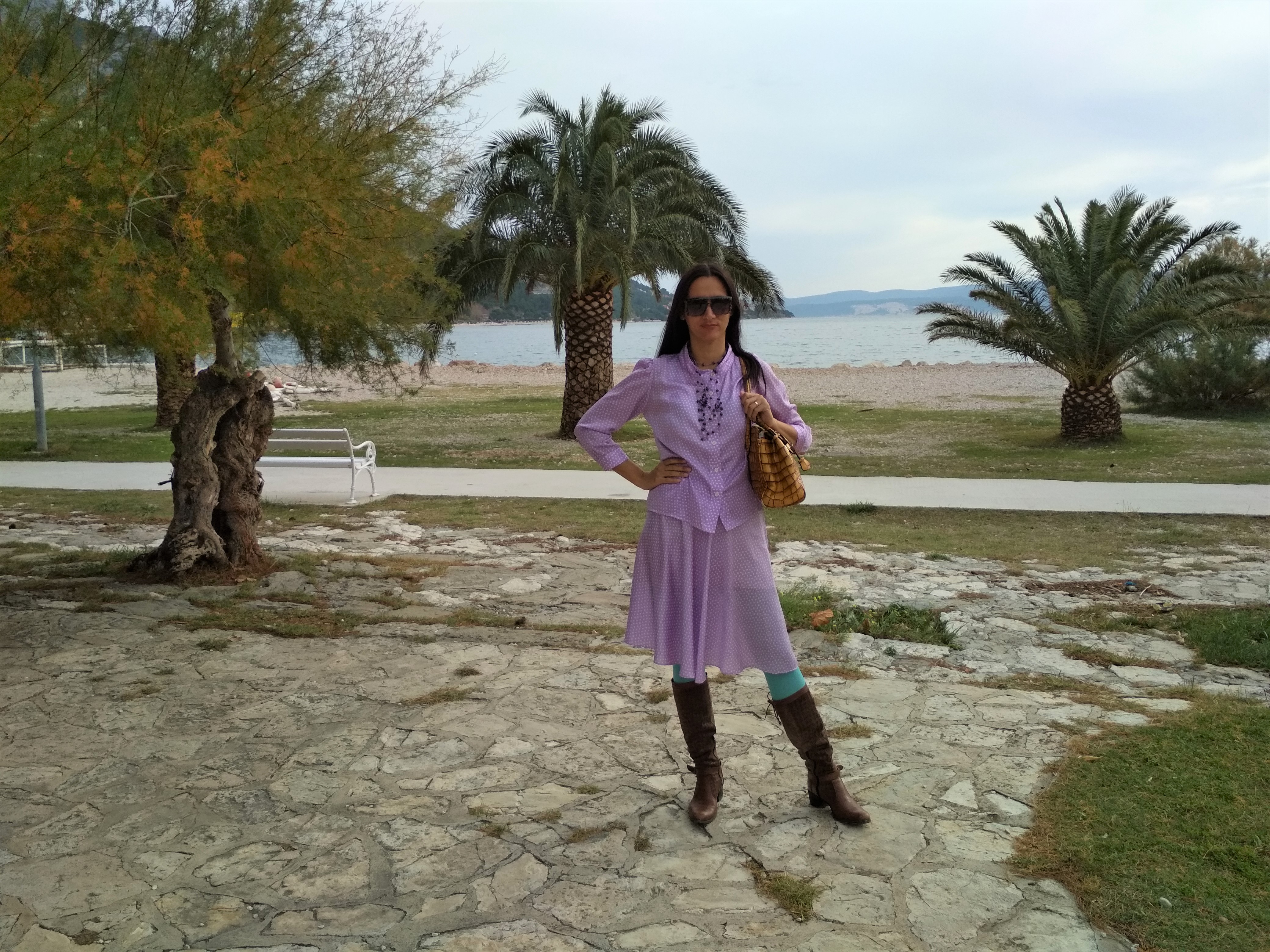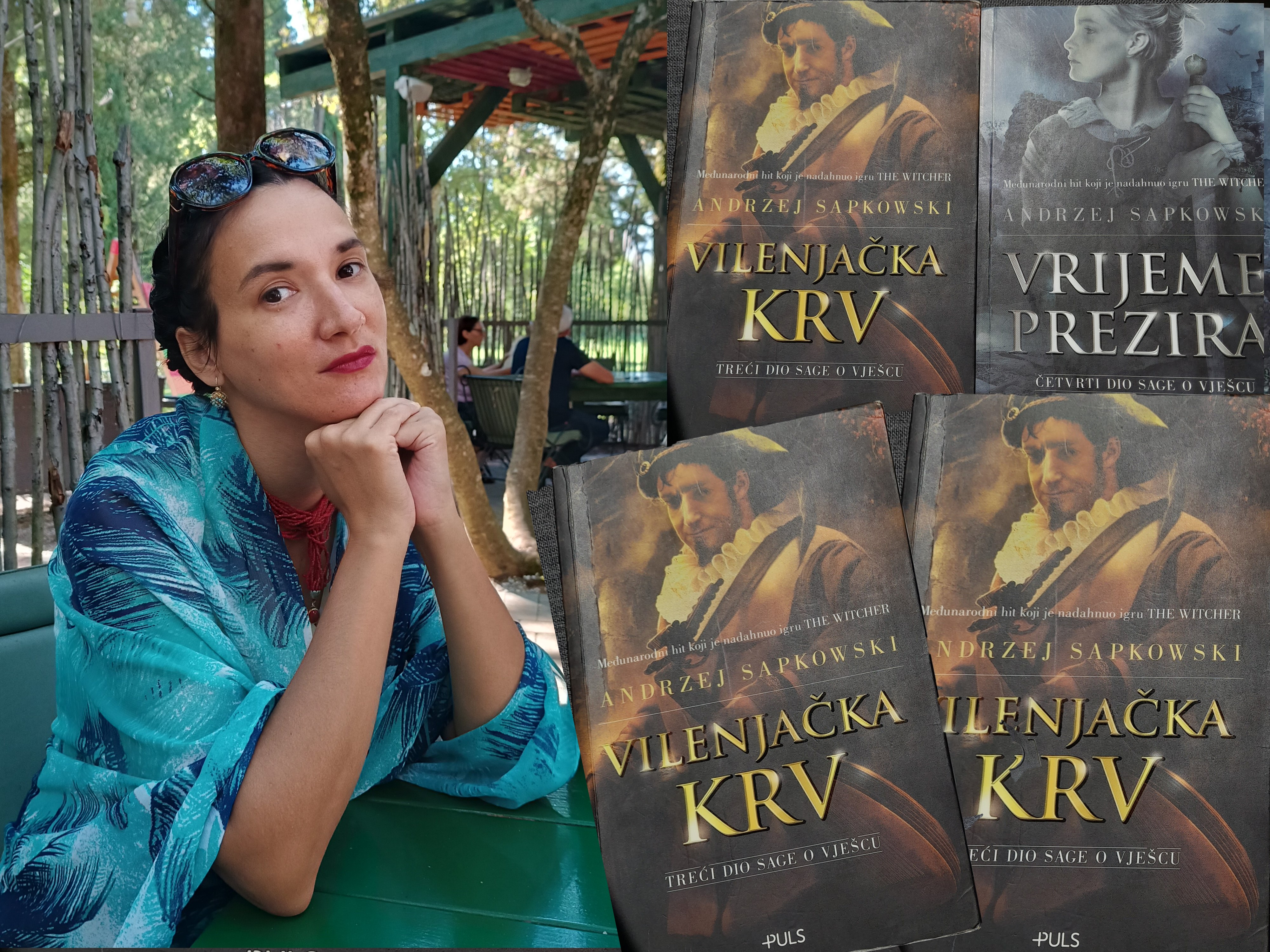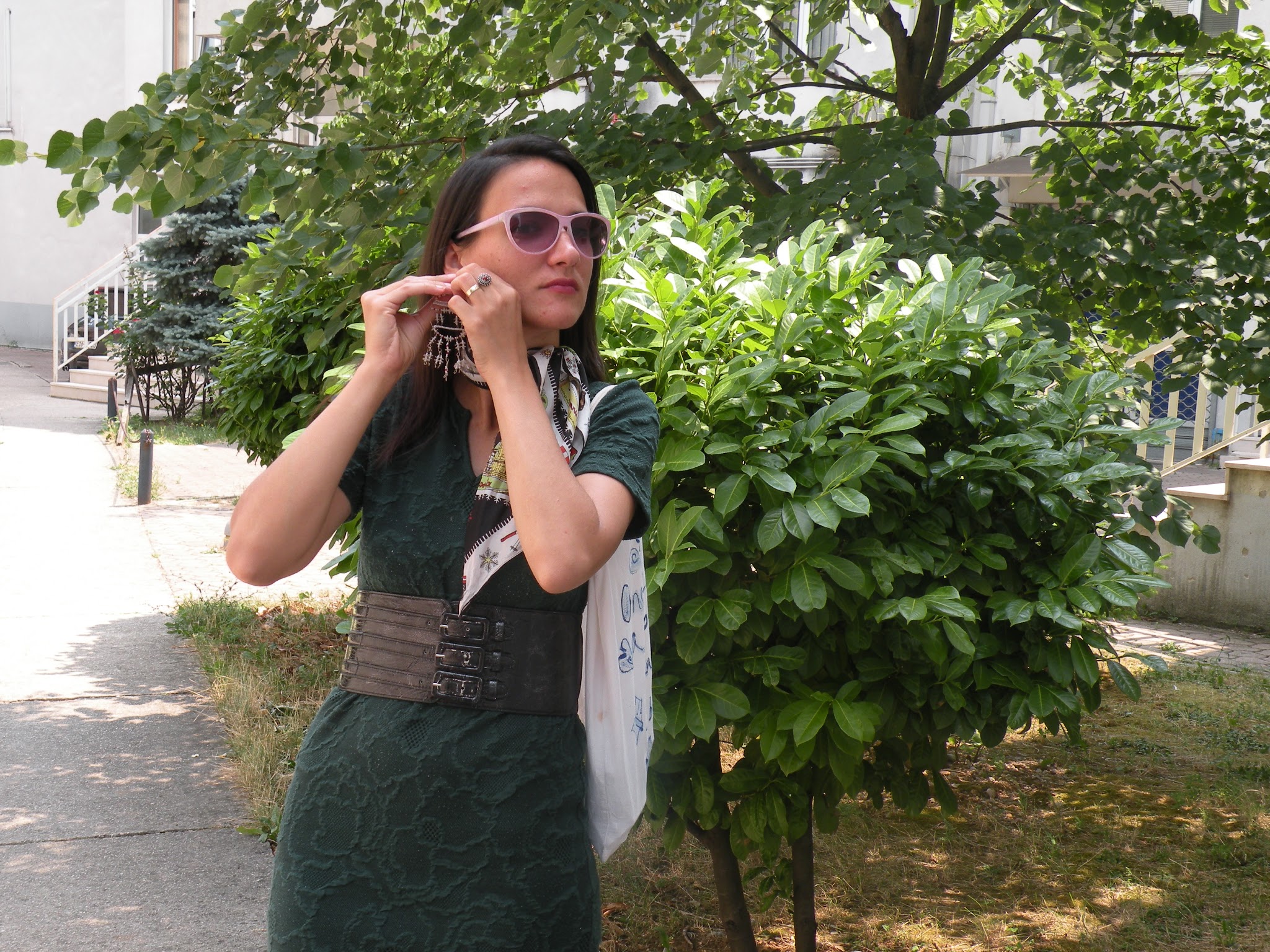VISIT OMIŠ (CROATIA) WITH ME (PART 2)
Hello! This is the second part of my travelogue focusing on Croatian town Omiš located in Dalmatia region. We stopped in Omiš at the end of the last year, following my appointment with a specialist in Split's hospital. We ended up having such a lovely time. The historical part of Omiš city is full of sights to see and enjoy, even if you don't have much time. I can't wait to visit Omiš town again.
Zdravo! Ovo je drugi dio mog putopisa koji se fokusira na hrvatski grad Omiš koji se nalazi u Dalmaciji. U Omišu smo stali krajem prošle godine, nakon mog pregleda kod specijaliste u splitskoj bolnici. Na kraju smo se tako lijepo proveli. Povijesni dio grada Omiša prepun je znamenitosti koje možete vidjeti i uživati, čak i ako nemate puno vremena. Jedva čekam ponovno posjetiti grad Omiš.
THINGS TO SEE IN OMIŠ IN A DAY
While walking, we came across a house with a sign 'the house of a happy man'. In Croatia, you will sometimes find signs on historical houses and palaces. After doing some research, I found information about this house on Visit Omis site. The following text is quoted from that site:
THE HOUSE OF A HAPPY MAN (16. C.)
Walking through the numerous narrow alleyways of the old town, almost at every corner you’ll discover a quaint little square or a charming house. One of them is especially cherished by the locals and interesting to tourists. After all, there aren’t many houses in the world with an official name, and let alone a name as peculiar as this one - "The House of a Happy Man". This beautiful Renaissance house got its name by a Latin inscription above the entrance that reads, in translation: "I thank thee, Lord, for having lived in this world" (GRATIAS AGO TIBI DNE QUIA FUI IN HOC MONDO). It is believed that it used to be the house of Ivan Primojević, a lawyer and the ambassador of Omiš commune in Venice. Unfortunately, not much is known today about its original owner, but the house itself has luckily been well preserved over the centuries and today represents one of the most beautiful examples of classic Dalmatian architecture of the Venetian period. "The House of a Happy Man" was originally built with the workshops and living room on the ground floor, sleeping quarters on the first floor and the kitchen on the top floor. Such an organization of the interior had baffled historians for a long time, until they finally figured out why medieval architects designed the interior in such a, seemingly, impractical way. The reason lay in the fact that many houses of the period suffered destruction by fire, and sources of fire are at home most commonly found in the kitchen. As houses with kitchens on lower floors were mostly turned into ashes in fires, the medieval inhabitants of Omiš realized with time that lifting the kitchen up to higher floors would significantly reduce the possible damage caused by fires, which soon made this particular form of interior design a standard in Omiš. "The House of a Happy Man " was one of the first ones in town to have been built in this – at the time still innovative – manner. Who knows, this may well be the reason why its owner‘s happiness ;)
KUĆA SRETNOG ČOVJEKA (16. ST.)
U šetnji brojnim omiškim kalama na gotovo svakom koraku možete naići na kakav zanimljiv trg ili kuću. Jedna od njih lokalnom stanovništvu posebno je draga, a turistima zanimljiva. Naposljetku, nema mnogo kuća na ovom svijetu koje imaju službeno ime, a kamoli tako zanimljivo kao ova omiška - "Kuća sretnog čovjeka". Ime je dobila po natpisu koji se nalazi iznad ulaznih vrata i na kojem, prevedeno s latinskog, piše: "Zahvaljujem ti, Gospode, što sam bio na ovom svijetu" (GRATIAS AGO TIBI DNE QUIA FUI IN HOC MONDO). Pretpostavlja se da je to bila kuća pravnika Ivana Primojevića, odvjetnika i ambasadora omiške komune u Veneciji. Nažalost, danas ne znamo mnogo o originalnom vlasniku ove prekrasne renesansne kuće, ali srećom kuća u kojoj je živio kroz mnoga je stoljeća dobro očuvana i danas predstavlja najljepši primjer klasične dalmatinske arhitekture iz venecijanskog perioda. "Kuća sretnog čovjeka" građena je tako da se u prizemlju nalazi radionica i dnevni boravak, na prvom katu spavaonice dok se tek na drugom i najvišem katu nalazi kuhinja. Ovakav način uređenja interijera dugi niz godina zbunjivao je povjesničare dok konačno nisu shvatili zbog čega su stari arhitekti unutrašnjost uredili na tako naizgled nepraktičan način. U Srednjem vijeku, naime, mnoge su omiške kuće uništene u požarima, a kako je poznato, vatra se u kućama najčešće može pronaći u kuhinji. Kuće kod kojih su kuhinje bile smještene na nižim katovima najčešće su uslijed požara pretvorene u prah. S vremenom, stari su Omišani shvatili da "podizanjem" kuhinje na više katove u slučaju požara štete postaju značajno manje te je uskoro ovakav način gradnje postao standardan u gradu. "Kuća sretnog čovjeka" jedna je od prvih u Omišu koja je izgrađena na ovaj, u tadašnje vrijeme inovativan, način. Tko zna, možda je upravo to razlog zbog kojeg je njen vlasnik bio toliko sretan ;)
While we were in Omiš, we saw a couple of historical churches. For more information about Omiš's historical churches, visit Omiš info. Today I'll show you two of them, the church of the Holy Spirit and the the church of saint Rocco.
CHURCH OF ST. PETER (X. C.)
Church of St Peter on the Western bank of the Cetina, in the part of town called Priko. Due to its well-preserved condition and architectural features the Church of St. Peter (10th century) is considered to be one of the most important examples of Early Croatian Pre-Romanesque sacral architecture, and it was first mentioned in 1074, during the rule of King Slavac.Zbog očuvanosti i arhitektonskih obilježja, značajan je predstavnik starohvatskog predromaničkog sakralnog graditeljstva, prvi put se spominje 1074.god. za vladavine kralja Slavca.
POLJICA SQUARE (EARLY 17. C.)
The place of the main market, grain trade and fairs. It got its more appealing appearance at the beginning of the 17th century, and it was decorated in 1811 during the regulation of the river bank. A flag pole with the coat of arms of providur Molina (1961) was also used for the announcement of orders and public punishment for minor offences.
CARALIPEO HOUSE (EARLY 17. C.)
An early Baroque building, one of the first buildings built among the family houses alongside the western town wall. An example of a two-story house with elegant balconies, which were built high on the second story because of the town wall. There is a memorial plaque in the honour of Pavle Caralipeo that was erected by Ivan Matulić and Ante Benković together with fellow citizens in 1981 for his merits in regulation of river bank.
PARISH CHURCH OF ST. MICHAEL (EARLY 17. C.) WITH A BELL TOWER (EARLY 18. C.)
It combines the stylistic features of Gothic style, Renaissance and early Baroque. A lavish portal from the workshop of the Bokanić family from the island of Brač, a window rosetta, the statue of St. Michael and the coat of arms of Omiš dominate the church. The coats of arms of Venetian providurs are located above the side entrance. The new bell tower was built according to the project of the Venetian engineer Giovani Battista Camozzini. The church also contains valuable sacred works of art.
THE CHURCH OF THE HOLY SPIRIT (1585.)
It was built in the place of a Gothic church that was completely renovated in 1585. Located under the Omiš kaštel, right in the heart of the old administrative buildings of the commune (town office and the writing office, and near the providur's palace) The altarpiece ˝The Descent of the Holy Spirit˝, was painted by Jacopo Palma Junior (early 17th century).
THE CHURCH OF ST. ROCCO (16. C.)
The church of the eponymous brotherhood. Francesco Negri painted the altarpiece ˝Virgin Mary with Jesus, St. Rocco and St. Sebastian˝, with the coat of arms of the Kačić Dukes.
St. Rocco and St. Sebastian are the patron saints of plague, which threatened the town on several occasions.
THE MONUMENTAL FIVE-SIDED FORTIFICATION (1659.)
The monumental five-sided fortification – the baroque bastion in the south-eastern part of the town – was built in the course of the Cretan War (fought between the Venetian Republic and the Ottoman Empire from 1645 until 1669), during the service of the Provveditore Antonio Bernardo. It consisted of the Turjun Fort (Torre di terraferma) and of “The Garden Gate“, which led to the fields and gardens on the sandy peninsula of Punta. Its strategic purpose was to deny the enemy access to the wide southern front along the moat (Italian fossa, today’s Fošal – the main road through the town centre). Its construction required huge amounts of stone, bulk materials and earthwork, and thus resulted in the town being cleared of all ruins and derelict houses.
The bastion was pulled down in 1862 along with the other fortifications, during the expansion of the town and the construction of new roads.
EASTERN TOWN DOOR (16. C.)
The Mainland Gates (Porta terraferma) are one of the better preserved parts of the eastern town walls. The main town street stretches from them towards the Western gates on the river. The inscription above the gate (1682) bears witness of their construction during Venetian rule.
PJACA (15/16. C.)
Pjaca, the main town street stretches from the Eastern Mainland Gates towards the large Western gates (˝vrata od rike˝, ˝the river gate˝). Its social role from the middle of the 20th century is taken over by Fošal – a modern town promenade and a road.
FOŠAL (2. HALF OF THE 19. C.)
A modern town promenade and a road built in the place of the moat (tal. fossa) and the devastated southern town walls. It is a witness of the expansion of the town during industrialisation and the modernisation of traffic routes.
THE HOUSE OF THE FESTIVAL OF DALMATIAN KLAPE OMIŠ (16. C.)
A one-story building with an additionally built Renaissance single window bearing the coat of arms of the Tomadelli family. Due to the cross in the coat of arms, it is also popularly referred to as ˝Biskupovi dvori˝ (The Bishop's Palace). The coat of arms of the Caralipeo-Despotović family (16th century) is located on the transom above the door.
TURJUN FORT (EARLY 17. C.)
The Angular, square-shaped ˝Kopnena kula˝ (Torre di terraferma) remained after the demolition and adaptation of parts of the southeastern town walls. ˝Vrata od vrtova“ ˝The garden gate“ stood next to it, which led to the fields and gardens on the sandy peninsula of Punta. Venetian coats of arms from various periods, originating from destroyed ruins and of the providur's palace, can be found on the facade of the fort.
THE COAT OF ARMS OF OMIŠ (1594.)
The coat of arms of Omiš is built into the side wall of the two-story building built in place of the town loggia and writing office during Venetian rule. Next to it there is a plaque bearing the motto BONUM DE MERO BONO (Pure goodness brings goodness) and the year 1594.
A TRANSOM FROM THE WESTERN TOWN WALL (1541.)
The inscription on the transom bears witness about the building of Great western gate („vrata od rike“ „the river gate“) and walls during the reign of providur Lorenzo Mini. The coat of arms of the providur and the herald of Omiš is located on the side.
THE CHURCH OF ST. EUPHEMIA (5-6. C.)
The Church of St. Euphemia (5th -6th century) - the remains of the single-nave early Christian church with a semi-circular apse and subsellium. The recently studied foundations, excavated during archaeological research in 2004, are mentioned in written sources from 1527. The church is dedicated to a Chaldecon martyr Euphemia, the patron saint of true faith.*
SOURCE: https://www.visitomis.hr/en/cultural-and-historical-heritage 18.4. 2022
ŠTO MOŽETE VIDJETI U OMIŠU?
Preuzeto sa stranice Visit Omiš, ovdje je popis zanimljivih znamenitosti koje možete vidjeti u Omišu.
CRKVA SV. PETRA (X. ST.)
Zbog očuvanosti i arhitektonskih obilježja, značajan je predstavnik starohvatskog predromaničkog sakralnog graditeljstva, prvi put se spominje 1074.god. za vladavine kralja Slavca.
.....
POLJIČKI TRG (POČ. 17. ST.)
Mjesto glavne tržnice, trgovine žitom i sajmova. Reprezentativniji izgled zadobiva poč. 17. st., a uređen je 1811. tijekom regulacije riječne obale. Štandarac za zastavu s grbom providura Molina (1671.), ujedno je služio za oglašavanje naredbi i javno kažnjavanje manjih prijestupa.
KUĆA CARALIPEO (POČ. 17. ST.)
Ranobarokna građevina, među prvim obiteljskim kućama sagrađenim uz zapadni gradski zid. Primjer dvokatnice s elegantnim balkonima koji su radi gradskoga zida postavljani visoko na drugome katu. Na njoj se nalazi spomen ploča koju su Pavlu Caralipeu postavili Ivan Matulić i Ante Benković sa sugrađanima 1811. zbog zasluga regulacije riječne obale.
ŽUPNA CRKVA SV. MIHOVILA (POČ. 17. ST.) SA ZVONIKOM (POČ. 18. ST.)
Objedinjuje stilske značajke gotike, renesanse i ranog baroka. Crkvom dominira raskošni kameni portal radionice bračke obitelji Bokanić, prozorska ruža, kip sv. Mihovila i grb Omiša. Na zidu iznad bočnog ulaza nalaze se grbovi mletačkih providura. Novi zvonik sagrađen je prema projektu mletačkog inženjera Giovannia Battiste Camozzinija. Posjeduje vrijedne sakralne umjetnine.
SV. DUHA (1585.)
Sagrađena na mjestu gotičke crkve koja je 1585. temeljito obnovljena. Smještena je ispod omiškog kaštela u žarištu nekadašnjih upravnih tijela komune (gradske lože i pisarnice, a blizu providurove palače). Oltarnu palu „Silazak Duha svetoga“, naslikao je Jacopo Palma Mlađi (poč. 17. st.).
CRKVA SV. ROKA (16. ST.)
Crkva istoimene bratovštine. Za oltar s grbom knezova Kačića, Francesco Negri naslikao je oltarnu palu „Bogorodica s Djetetom, sv. Rokom i Sebastijanom“. Sv. Roko i Sebastijan, zaštitnici su od kuge koja je u nekoliko navrata ugrožavala grad.
MONUMENTALNI PETEROSTRANI BASTION (1659.)
Monumetalni peterostrani bastion – barokni baluard na jugoistoku grada, izgrađen je tijekom Kandijskog rata (1645.-1669.) između Mletačke Republike i Osmanlijskog carstva, a za vrijeme uprave generalnog providura Antonija Bernarda. Obuhvaćao je kulu Turjun (Torre di terraferma) i „Vrata od vrtova“ koja su vodila do polja i vrtova na pješčanom poluotoku Punti. Strateški je onemogućavao pristup napadačima do široke južne fronte uz jarak (današnji Fošal). Za izgradnju je bila potrebna velika količina kamene građe, šute i zemlje, stoga je grad očišćen od ruševina i zapuštenih kuća.
Srušen je 1862. kad i preostale zidine, pri širenju grada i izgradnji novih prometnica.
ISTOČNA GRADSKA VRATA (16. ST.)
Kopnena vrata (Porta terraferma) pripadaju dobro sačuvanim istočnim gradskim zidinama. Od njih se prema Zapadnim vratima na rijeci proteže glavna gradska ulica. Natpis iznad vrata (1682.) svjedoči o njihovoj gradnji za mletačke uprave.
PJACA (15/16. ST.)
Glavna gradska ulica, proteže se od Istočnih kopnenih vrata do velikih Zapadnih vrata („vrata od rike“). Njenu društvenu ulogu od sred. 20. st., preuzima Fošal – moderno gradsko šetalište i prometnica.
FOŠAL (2. POL. 19. ST.)
Moderno gradsko šetalište i prometnica izgrađena na mjestu obrambenog vodenog jarka (tal. fossa) i porušenih južnih gradskih zidina. Svjedoči o širenju grada uslijed industrijalizacije i modernizacije prometnih puteva.
KUĆA FESTIVALA DALMATINSKIH KLAPA OMIŠ (16. ST.)
Jednokatnica s naknadno uzidanom renesansnom monoforom s grbom obitelji Tomadelli. Zbog križa u grbu ista je u pučkoj predaji zvana „Biskupovi dvori“. Na nadvratniku prije ulaza nalazi se grb obitelji Caralipeo-Despotović (16. st.).
KULA TURJUN (POČ. 17. ST.)
Ugaona, kvadratna Kopnena kula (Torre di terraferma), preostala nakon rušenja i adaptacije dijelova jugoistočnih gradskih zidina. Uz nju su se nalazila „Vrata od vrtova“, koja su vodila do polja i vrtova na pješčanom poluotoku Punti. Na pročelju kule su sačuvani mletački grbovi iz raznih razdoblja, sa srušenih zidina i providurove palače.
GRB OMIŠA (1594.)
Grb Omiša uzidan s bočne strane dvokatnice sagrađene na mjestu gdje je za vrijeme mletačke uprave bila gradska loža i pisarna. Do njega ploča s krilaticom BONUM DE MERO BONO (Dobro nam dolazi iz čistoga dobra) i godinom 1594.
NADVRATNIK SA ZAPADNIH GRADSKIH VRATA (1541.)
Natpis na nadvratniku svjedoči o gradnji Zapadnih velikih vrata („vrata od rike“) i zidina u vrijeme providura Lorenza Minija. Bočno se nalazi grb providura i grb Omiša.
CRKVA SV. EUFEMIJE (5-6. ST.)
Ostaci jednobrodne ranokršćanske crkve s polukružnom apsidom i supselijom. Nedavno istraženi temelji, otkopani 2004. tijekom arheoloških istraživanja, spominju se u pisanim izvorima 1527. Crkva je posvećena kalcedonskoj mučenici Eufemiji, zaštitnici pravovjerja.
SPOMENICI
SPOMENIK HRVATSKIM BRANITELJIMA
Spomenik je rad akademskog kipara Kažimira Hraste, dok je arhitektonski dio projektirao arhitekt Viktor Pirović.
Brončani spomenik postavljen je na predjelu Toreta, uz samu obalu. Ima oblik lepršave zastave s otiscima dlanova članova obitelji poginulih, koji simbolično označavaju neprekinutu povezanost živih s onima koji su živote dali za slobodu naše domovine. Zastava na simboličan način prikazuje i vizure Omiša jer u tlocrtu izgleda kao tok rijeke, a gledana frontalno podsjeća na brda koja okružuju Omiš.
Na spomeniku su upisana imena 65 hrvatskih branitelja iz Omiša poginulih u Domovinskom ratu.
Svečano je otkriven u svibnju 2004.*
IZVOR: * https://www.visitomis.hr/hr/kulturna-i-povijesna-bastina, preuzeto 18.4.2022









.jpg)












Beautiful post Ivana. Thank you
ReplyDeleteThank you
DeleteI didn't want to know much about Omis, but only now do I see how much I don't know. You thrilled me with this post, the next time I am in Omis I will visit these places because you intrigued me :) Thank you for taking us through beautiful Croatian places full of history!
ReplyDeleteThanks
DeleteHey Ivana, I hope you're having a magical Spring season and thanks for the sweet comments on my blog posts :)
ReplyDeleteThis travel posts are stunning since I can travel digitally with you through places that are on my bucket list. Wishing to visit Croatia soon since I have heard a lot of interesting comments about it! Actually many of the photos you posted in this blog post reminded me a little bit of Spain and sometimes when they want to recreate Spain cities they go and film in Croatia.
The Church of Sant Rocco and the Five Faces Fortification took my breath away! Thanks also for sharing bits of the story in a simple way. Sometimes many of these places have many anecdotes that it is difficult to sum up all those stories in one single post right? But you made a great job by taking us through these alleways *_*
I also loved the outfit you picked in lilac and how you styled with the black jacket, it makes a really interesting contrast!
Checking it out the 1st part since this one was really good!
Pablo
www.HeyFungi.com
Yes, a lot of films and series are filmed in Croatia.
DeleteOmiš is beautiful! Omiš je predivan! :)
ReplyDeleteLove your photos and also your outfit looks cute and playful, love it!
Have a great day! <3
🌸 Kiara Era BLOG 🌸
Kisses,
Kiara Era
💕💕💕💕💕
DeleteOmiš city looks scenic and the architecture is so beautiful! You look lovely in the lilac dress or is it a two-piece. I hope you are taking care of yourself. Thank you for sharing this beautiful city, I've never been to it. Just to let you know, the font size for this post is tiny so it's hard to read for me. Hope they're back to their usual reading size ;) xoxo
ReplyDeleteThank you. I used smaller letters for the part of the post I quoted. I can make them bigger.
DeleteVery interesting photos ;)
ReplyDelete💕
DeleteOh very cute darling
ReplyDeletegood photos
💕💕💕
DeleteMeravigliosa Ivana le tue località sono sempre sorprendenti
ReplyDeleteGrazie
DeleteI can't believe what a wealth of treasures are packed into Omiš city! Quite impossible, it seems, to see it all on a day trip! I'm loving the churches, the Church of the Holy Spirit in particular. I also loved the story of The House of the Happy Man, and thank you for explaining the reason why in Roman houses the kitchen was installed on the top floor! xxx
ReplyDeleteYes, isn't it fascinating?
DeleteSuch a beautiful and historical place. Lovely church! Awesome trees too! Love the dress you wore. Such a wonderful and informative post!
ReplyDelete💕💕💕
DeleteWonderful place to visit. Such a quaint and beautiful church too. So great to see you in that color. And love those traveling boots of yours too! Thanks for the lovely travel post!
ReplyDelete❤
DeleteDear Ivana,
ReplyDeletethat really does look like a beautiful place - and isn't it wonderful that a man could become immortal by the fact of having been happy?! (Others only want to become immortal through power or wealth... - being happy is much more likeable!) You look wonderfully colorful with your pretty two-piece suit between the stone walls of the city! I hope the health treatments could help you!
All the best,
Traude
https://rostrose.blogspot.com/2022/04/italien-reisebericht-zwei-relaxtage-und.html
💕
DeleteYou look so lovely in your lilac pink outfit, Ivana. What a cool place - I love the story of the House of the Happy Man! It totally makes sense to have kitchen on the top floor!
ReplyDeleteThanks 💕
DeleteQue bello es tu país como me gustaría conocerlo. Te mando un beso.
ReplyDelete💕💕💕
DeleteThe lovely necklace + dress combo that you are sporting here is sooo good! The two compliment each other as perfectly as Eastertime and chocolate eggs. :)
ReplyDeleteBig hugs,
Autumn Zenith 🧡 Witchcrafted Life
💕
DeleteAmazing place
ReplyDelete💕
DeleteThe House of the Happy Man! how wonderful that sounds! xxx
ReplyDelete💕
DeleteWe always love seeing the historical places like this. And the house of a happy man?? That's so fabulous. I want to put a sign outside our house like that.
ReplyDeleteXOXO
Jodie
www.jtouchofstyle.com
💕💕💕💕
DeleteOmiš is not only a pretty town but it has so much rich history as well.
ReplyDeleteYes, I do love its history.
Delete